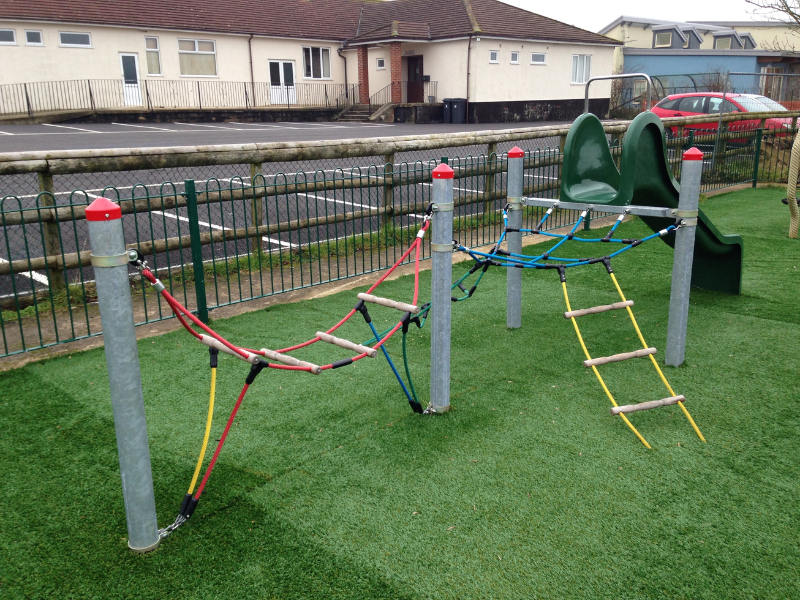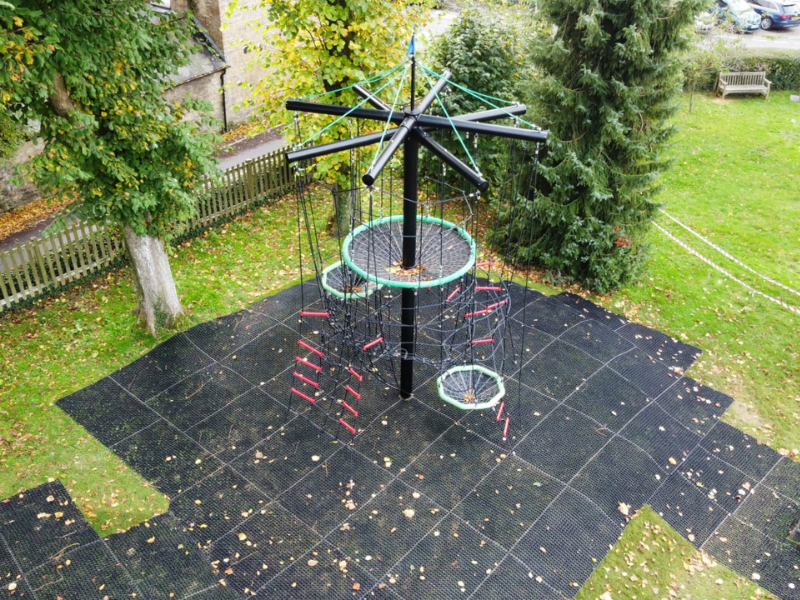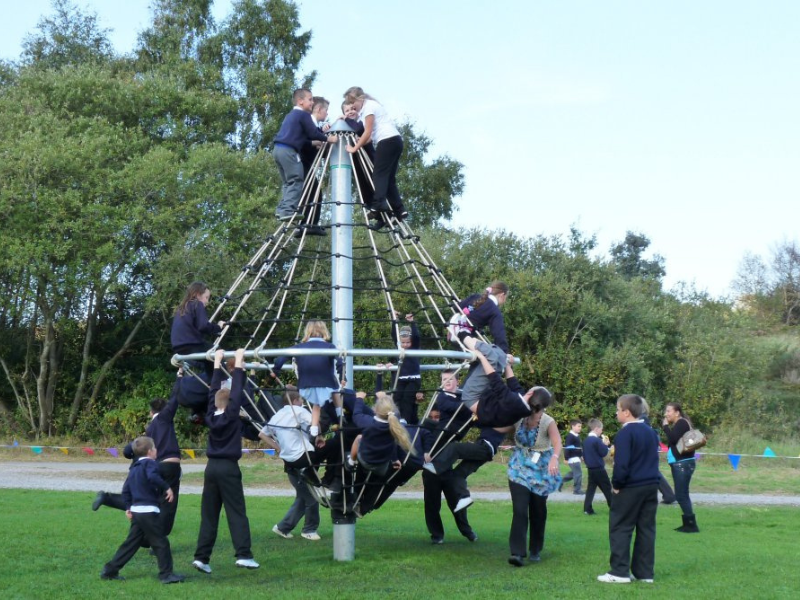What is the Best Ground Cover for a Playground? Our Experts Weigh in
Ground cover is a key element of any children's playground as it provides a safe and comfortable surface for kids to play on. There are many types available, each with its own pros and cons. So, how do you know what ground cover is the best choice for your playground?
Having worked to bring to life countless playgrounds across the UK, our installation team have completed projects with varying ground coverings.
And while there’s not necessarily any ‘wrong’ choice, you may find some covering options to be more suitable for your specific site, budget and users.
We’ve asked our team of experts at Huck Play to weigh in on the topic and give their top recommendations for ground cover options for playgrounds.
What is the Purpose of a Playground Ground Cover?
Ground covers, whether they’re turf, sand, or rubber, serve as a protective layer for children when they’re playing on playground equipment.
It’s inevitable that some tumbles and falls will happen on the playground, so it’s important to have a safe surface for kids to land on, which is where ground covers come in.
Rather than falling onto concrete or hard ground, a proper ground cover can help absorb some of the impact and reduce the risk of serious injuries.
But aside from their safety purpose, they also add a visual appeal to the playground and can help create a more inviting and playful atmosphere for children. Some of them can be painted on or coloured (like rubber mulch) to add even more fun and creativity!
The Most Popular Playground Ground Cover Materials
There are many different types of ground covers that you can choose for your playground, each with its own benefits, drawbacks, costs, and installation methods.
Really, they’re all good choices, but certain types may work better for your specific needs and budget.
So let’s take a look at some of the most popular playground ground cover materials to help you figure out which is best for your site…
| #1 Sand Ground Cover |
| #2 Pea Gravel Ground Cover |
| #3 Engineered Wood Fibre Ground Cover |
| #4 Artificial Turf Ground Cover |
| #5 Synthetic Tiles Ground Cover |
| #6 Poured-in-Place Rubber Ground Cover |
| #7 Natural Grass Ground Cover |
#1 Sand Ground Cover
Sand is a popular choice for playground ground cover due to its natural cushioning properties.
It provides a soft landing surface that helps to reduce the likelihood of injuries from falls, making it a safer option for children at play.
Sand is also readily available and relatively inexpensive compared to other materials, which makes it a cost-effective solution for many playgrounds.
Additionally, sand offers a versatile play medium, allowing children to engage in creative activities such as building and digging.
|
Pros:
|
|
Cons:
|
#2 Pea Gravel Ground Cover
Pea gravel is another common choice for playground ground cover, known for its smooth, rounded stones that provide a safe and aesthetically pleasing surface.
Pea gravel provides a good cushioning effect, which helps in reducing the risk of injuries from falls.
The material's natural drainage properties prevent water accumulation, making the playground usable during and after rain.
Furthermore, pea gravel is durable and long-lasting, requiring minimal maintenance compared to some other ground cover options.
|
Pros:
|
|
Cons:
|
#3 Engineered Wood Fibre Ground Cover
Engineered wood fibre (EWF) is a popular playground ground cover due to its safety, accessibility, and environmental benefits. EWF consists of finely ground wood particles that create a compact, cushioned surface, reducing the risk of injuries from falls.
It complies with the Equalities Act, making playgrounds more accessible for children with mobility issues and those using wheelchairs.
EWF is also an eco-friendly option. It is typically made from recycled wood, contributing to sustainability.
Its quick drainage keeps playgrounds usable shortly after rain, preventing slippery conditions.
While regular maintenance like raking and replenishing is needed, the safety and inclusiveness benefits make EWF an excellent ground cover choice for playgrounds.
How to Design A Playground That’s Popular & Inclusive
|
Pros:
|
|
Cons:
|
#4 Artificial Turf Ground Cover
Artificial turf is a popular choice for children's play areas due to its safety, aesthetics, and low maintenance. It provides a uniform, cushioned surface that reduces injury risks from falls, making it safe for active kids.
Its grass-like appearance enhances the playgrounds' visual appeal, maintaining a clean, vibrant look year-round.
Additionally, artificial turf requires much less maintenance than natural grass, as it doesn't need mowing, watering, or fertilising, making it cost-effective in the long run.
It's also weather-resistant, ensuring play areas stay usable in various conditions without becoming muddy or slippery.
Its antimicrobial properties help maintain hygiene, reducing the spread of germs and bacteria.
|
Pros:
|
|
Cons:
|
#5 Synthetic Tiles Ground Cover
Synthetic tiles are an excellent playground ground cover due to their safety, durability, and versatility. These interlocking tiles create a smooth, cushioned surface that reduces injury risks from falls, ensuring a safe play area for kids.
Their shock-absorbing qualities meet safety standards, giving parents and caregivers peace of mind.
Beyond safety, rubber tiles are tough and can withstand heavy use without wearing down. They last longer, making them a cost-effective choice since they don't need frequent replacement.
Synthetic tiles' non-slip surface adds extra safety by reducing slips and falls. Available in various colours and designs, they can also make playgrounds more appealing and inviting.
|
Pros:
|
|
Cons:
|
#6 Poured-in-Place Rubber Ground Cover
Poured-in-place (PIP) rubber is a popular choice for playground surfaces because it's safe, accessible, and durable.
As a seamless surface, PIP rubber provides a cushioned layer that reduces the risk of injury from falls and meets safety standards. Its impact-absorbing qualities make it perfect for playgrounds where children often fall.
PIP rubber is also versatile and customisable with various colours and patterns, making play areas more attractive.
It complies with the Equalities Act, offering a stable and accessible surface for children with disabilities, including those using wheelchairs.
One major benefit of PIP rubber is that it is low-maintenance. It’s also durable, withstands heavy use and harsh weather, and doesn’t need frequent replacements.
The surface is easy to clean and resists mould, mildew, and other contaminants, ensuring a hygienic play environment.
|
Pros:
|
|
Cons:
|
#7 Natural Grass Ground Cover
Natural grass is sometimes used as playground ground cover for its aesthetic and cushioned surface.
While it benefits the environment, it requires regular maintenance and can become muddy during wet weather, which may limit its practicality.
Kickstart Your Playground Project With Huck Play
At Huck Play, we offer expert advice and comprehensive playground design and installation services to help you create a safe and fun play space for children.
By combining quality ground covers with our industry-leading rope-based equipment, we can help you design a playground that is not only visually appealing but also durable and safe for children to play on.
Ready to get started on your playground project? Contact us today to learn more about our services and see how we can help bring your vision to life!
FAQs
Pea gravel is generally safe for playgrounds as it provides good drainage and a moderately cushioned surface. However, it can pose choking hazards for younger children and may not be as impact-absorbent as other materials like rubber or synthetic tiles. Our end-to-end service cost varies based on the size and specifics of the playground project. It includes consultation, design, material selection, and installation to ensure a safe and aesthetically pleasing play area. Contact us today for a tailored quote. The best material to put under a swing set is poured-in-place rubber. It provides excellent impact absorption, reducing injury risks from falls. Its seamless, durable surface ensures safety and longevity. Also, it's easy to maintain, keeping the area clean and accessible for all children. We've been designing and manufacturing rope-based playground equipment for over 20 years. So, our team has extensive experience creating high-quality, accessible, and safe playgrounds for schools, communities, and commercial businesses. We do not offer ground cover installation services, but we can provide recommendations for professional installers in your area.Is Pea Gravel Safe for a Playground?
How Much Does Your End-to-End Service Cost?
What Ground Cover is Best to Put Under a Swing Set?
How Much Experience Do You Have in Designing Playgrounds?
Do You Offer Ground Cover Installation?







